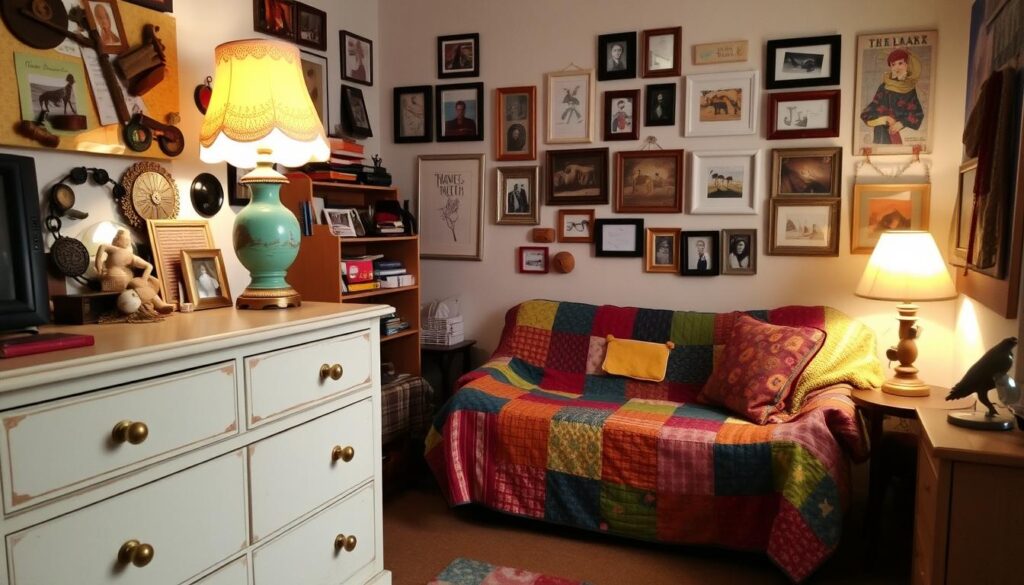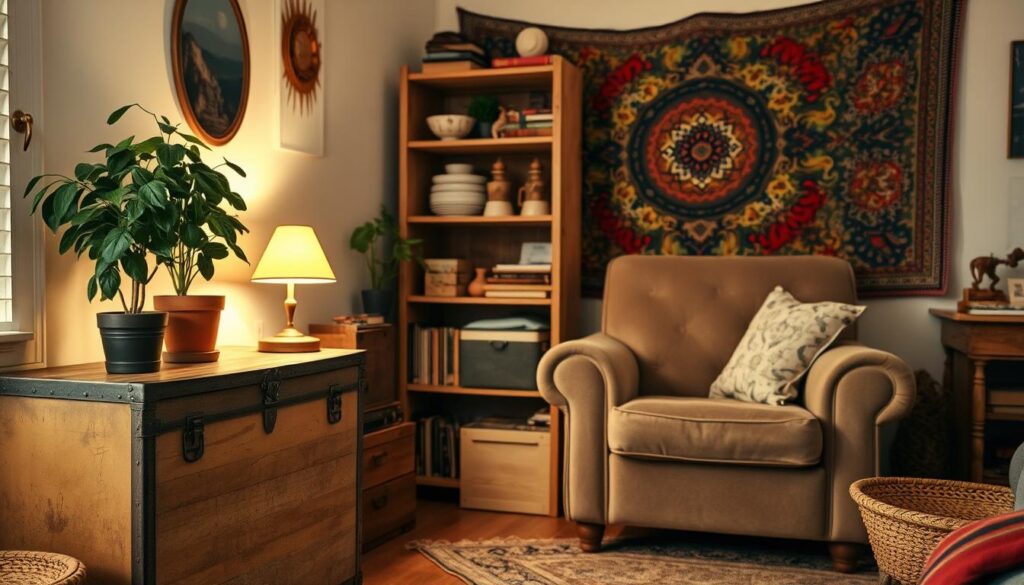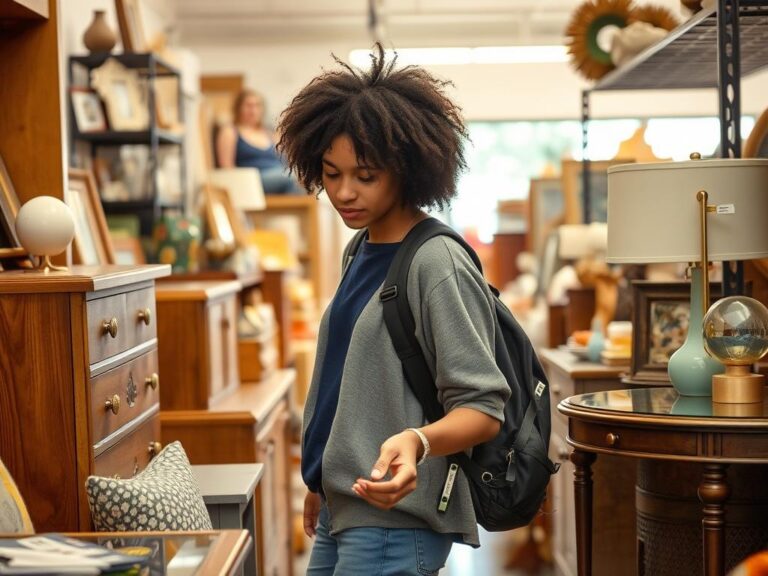How to upcycle thrifted items for your dorm decor
Transform your dorm space with creative upcycling thrifted items for dorm decor. Check out our listicle for easy and stylish DIY decor ideas to make your dorm stand out.
Moving into campus housing marks a fresh start for students, but blank walls and tight budgets often clash with creative ambitions. Ohio Valley Goodwill reports that 72% of North American students live in temporary housing, creating massive demand for affordable room transformations. With the average learner generating 640 pounds of annual waste, eco-conscious solutions matter now more than ever.

Breathing new life into pre-owned treasures cuts costs while reducing landfill contributions. A recent survey shows 68% of undergraduates prioritize sustainability when decorating their living areas. This method turns forgotten furniture and accessories into conversation-starting pieces that showcase personal style.
From vintage lamps to retro storage solutions, secondhand stores offer endless possibilities for crafting unique environments. Students save an average of $300 per semester by repurposing materials instead of buying new. These projects also build practical skills in design, budgeting, and resourcefulness that last beyond graduation.
Key Takeaways
- Personalize small spaces without overspending
- Reduce environmental impact through creative reuse
- Develop lifelong DIY and design abilities
- Mix functionality with self-expression
- Transform basic rooms into memorable homes
Setting the Scene: Dorm Decor on a Budget
Empty wallets meet empty walls: How savvy learners craft personalized spaces without overspending. Campus living often means balancing tight funds with the desire for a welcoming environment. Strategic shopping at local secondhand outlets unlocks solutions that address both financial and spatial constraints.
Benefits of Thrifting for Your Dorm
Secondhand shopping cuts decor costs by 60-80% compared to retail stores, according to Goodwill market research. Students discover quality lamps, mirrors, and textiles for less than $10 each. This approach preserves cash for textbooks while reducing fast furniture waste – a win for wallets and ecosystems.
Maximizing Small Spaces with Creative Ideas
Compact living demands clever layouts. Try stacking vintage suitcases as bedside tables or using hanging baskets for vertical storage. One UCLA student transformed a $5 wooden crate into a floating shelf that holds plants and study supplies. “Multi-functional pieces make all the difference,” she notes.
What Else Would You Like to Know?
Choose below:
Color coordination ties eclectic finds together. Paint mismatched frames the same hue for cohesive wall art. Foldable stools double as side tables during movie nights. These space-saving strategies prove style doesn’t require square footage – just imagination.
upcycling thrifted items for dorm decor
Smart planning turns secondhand treasures into functional room upgrades. Start by measuring your space using college-provided floor plans – 83% of universities now offer digital layouts. This helps identify what essential pieces you need before hitting local shops like Goodwill.

Focus on sturdy finds with good structural integrity. A chipped dresser becomes a chic storage unit with fresh paint, while mismatched mugs transform into pencil holders. “Look beyond an object’s original purpose,” advises a UC Berkeley design student. “My favorite lamp started as a retro kitchen gadget.”
| Essential Item | Potential Use | Modification Tips |
|---|---|---|
| Wooden Crate | Floating Shelf | Sand, paint, add L-brackets |
| Fabric Scraps | Wall Tapestry | Stretch over canvas frame |
| Glass Jars | Desk Organizers | Wrap with twine or washi tape |
| Old Sweater | Pillow Cover | Stuff with polyfill, sew edges |
Keep a flexible mindset during shopping trips. That scratched picture frame? Perfect for displaying concert tickets. Those outdated curtains? Ideal material for reupholstering chair seats. Simple changes like spray-painting hardware or swapping knobs create cohesive styles.
Quality matters more than surface appearance. Check furniture joints and fabric durability. With basic tools and creativity, you’ll craft a space that feels like home without draining your budget.
DIY Wall Art and Lighting Ideas
Sterile walls and harsh overhead fixtures don’t have to define student living spaces. Ohio Valley Goodwill’s inventory of picture frames provides endless opportunities to craft personalized displays. A recent campus survey found 79% of students feel more motivated in rooms with customized wall art.
Creating a Gallery Wall with Repurposed Frames
Mix and match secondhand frames to build dynamic arrangements. Sand rough edges and spray-paint metallic finishes for cohesion. Add depth by layering pressed leaves or fabric scraps behind glass panes. One design student shares: “My gallery wall cost $12 total but gets more compliments than my roommate’s expensive posters.”
Illuminating Your Space with String Lights
Swap stark fluorescent lights for warm string lights that cast inviting glows. Drape them above beds or weave through floating shelves. Opt for battery-operated LEDs with adjustable brightness—perfect for late-night study sessions. Color-changing bulbs let rooms shift from focused workspaces to cozy hangouts in seconds.
Pair framed art with strategic lighting placements to highlight favorite pieces. Clip-on mini spotlights add drama to gallery displays. These combos prove transformative design doesn’t require professional skills—just creative vision.
Revamping Dorm Essentials with Thrift Store Finds
Compact campus living demands clever organizational strategies that balance form and function. Secondhand shops like Goodwill overflow with untapped potential for storage solutions that maintain order without sacrificing style. A recent campus survey revealed 82% of students consider organization systems crucial for academic success in tight quarters.
Smart Storage and Multi-Use Items
Woven baskets prove indispensable for taming clutter. Available in various sizes at local thrift stores, these versatile containers corral textbooks under desks or conceal snacks beside beds. “I lined mine with fabric scraps to match my bedding,” shares a University of Michigan sophomore.
Furniture with hidden compartments maximizes limited square footage. Convert vintage suitcases into under-bed storage or transform wooden crates into stackable shelving units. Ottomans with lift-up lids serve triple duty as seating, tables, and secret stashes for seasonal clothes.
Strategic placement turns ordinary finds into room-enhancing features. Mount baskets vertically to display plants or hang colorful bins near doorways for quick-access essentials. These adaptable systems grow with changing needs throughout the academic year, proving that practical dorm essentials can also elevate a space’s visual appeal.
Green DIY: Upcycled Planters and Nature-Inspired Decor
Bringing greenery into student spaces transforms sterile environments while supporting eco-friendly habits. Ohio Valley Goodwill’s inventory includes various containers perfect for housing leafy companions. These projects merge sustainability with style, creating vibrant accents that boost focus and relaxation.
Mason Jar Planters and Reused Containers
Clear glass vessels make ideal homes for small botanicals. Try these conversions:
| Container | Plant Type | Care Tips |
|---|---|---|
| Mason jars | Air plants | Mist weekly |
| Ceramic mugs | Succulents | Water every 2 weeks |
| Teacups | Herbs | Sunny windowsill |
| Salad bowls | Pothos vines | Trim monthly |
Add drainage holes using a diamond drill bit for live specimens. “My mint grows better in a thrifted soup tureen than store-bought pots,” notes a Cornell University junior.
Bringing Indoor Plants and Faux Greens into Your Space
Low-light varieties thrive in academic settings. Snake plants filter air and survive irregular watering. Pair real specimens with silk flowers for lush displays without maintenance stress.
Cluster containers at varying heights using stacked books or crates. This technique adds dimension to desks and windowsills. For dark corners, realistic fake ivy draped over shelves provides greenery without sunlight needs.
Innovative DIY Projects: Personalized Decor from Unexpected Items
College spaces become personality showcases through clever transformations of overlooked objects. With basic crafting supplies and imagination, everyday finds evolve into functional statements. This approach turns mundane pieces into custom solutions that serve both practical and aesthetic needs.
Transforming Old Frames into Mood Boards
Discarded picture frames gain new purpose as visual planning tools. Remove glass panes and staple fabric scraps to the backing board. Use pushpins to display photos, class schedules, and motivational quotes. A University of Texas student shares: “My mood board helps me track deadlines while showing off concert tickets from freshman year.”
Crafting Custom Pillows from Thrifted Fabrics
Textile treasures like vintage scarves or curtain panels make unique cushion covers. Follow this simple guide:
| Fabric Type | Pillow Size | Style Tip |
|---|---|---|
| Floral Sheets | 18×18″ | Add tassel corners |
| Denim Jeans | 12×16″ | Use back pockets for storage |
| Knit Sweaters | Round Bolster | Incorporate buttons |
Small bowls double as desk organizers for paperclips and rings. Paint mismatched saucers in coordinating colors to group essentials. These ways to use common items prove creativity beats costly purchases every time.
Mirror makeovers offer another customization opportunity. Apply chalkboard paint to create message centers, or glue seashells around the edges for coastal vibes. These projects turn castoffs into conversation starters while keeping spaces tidy and inspired.
Conclusion
Crafting welcoming college living areas becomes rewarding when combining creativity with conscious consumption. Shopping at local secondhand stores like Goodwill offers triple benefits: saving money, reducing waste, and supporting community programs. Students gain access to quality materials while keeping 640+ pounds of annual waste out of landfills.
These sustainable shopping habits build practical skills that outlast campus life. Transforming finds into functional pieces teaches problem-solving and design thinking. The process turns generic dorms into personalized spaces that spark joy through unique styles.
Beyond financial savings, this approach fosters environmental responsibility. Each repurposed item contributes to circular economies while freeing up funds for academic priorities. Time spent on projects also becomes a creative outlet during stressful semesters.
Communities benefit when students choose secondhand stores. Purchases fund job training and social services, creating positive local impact. This method proves stylish living spaces don’t require big budgets – just smart ways to reimagine existing resources.
Next campus move-in day, skip big-box stores. Explore neighborhood thrift shops first. With vision and basic tools, you’ll craft a home that reflects your personality while protecting the planet.
FAQ
How can I save money while decorating my dorm room?
What are creative ways to display photos in a small space?
How do I add greenery to my dorm without taking up desk space?
Can I repurpose old fabrics for decor?
What thrift store items work best for organizing supplies?
How can I brighten my dorm without harsh overhead lighting?
How to Decorate a Studio Apartment for Under $100: Student-Friendly Hacks
» See exclusive tips for your home








